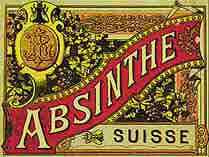

This drink really does deserve its own spot, due to its (largely undeserved) reputation as something of a dangerous phenomenon.
Absinthe gets historical mention as far back as Biblical, Egyptian and early Syrian times; in its original form, it was simply wine that had been steeped with wormwood (Artemisia absinthium) leaves. The plant is a shrub native to Europe and Asia.
The more recent manifestation of the drink is quite different, being spiritous in nature and including a range of other herbs (fennel, anise, coriander, hyssop, sage, thyme among others). It was trendy throughout Europe, but particularly in France and Switzerland, around the beginning of the 20th century, and was popularly known as Le Fée Verte (the green fairy). Famous advocates included Baudelaire, Rimbaud, Oscar Wilde, Aleister Crowley, Van Gogh and Gaugin.
By 1915, however, absinthe had been banned across Europe and in the United States, the only specific alcohol to be targeted aside from general abolitionist movements. Absinthe, in a historical case highly reminiscent of modern drug policies and "wars", was scapegoated as the cause for many social problems of the time, falling birth rates, a series of absinthe related murders, and mostly, a growing awareness for the first time in political consciousness of alcoholism as a social problem in general.
The drink is now enjoying something of a revival since a few British companies have secured contracts with tiny Spanish and Czech absinthe producers after discovering that the drink was never formally prohibited in the United Kingdom - it's even available in supermarkets. Despite its fairly high price (I paid £20 for 50cl), it works out as good value due to its high alcohol content - it should be in the 60 - 80% range, plus you only need a little in some cocktails as its flavour tends to dominate.
The active ingredient of wormwood is thujone, and thujone has been proven identical to tanecetone in the herb tansy and salvanol in sage. Thujone has also been said to have similarities with the molecular structure and action of THC, though more scientific argument has debunked this myth.
1 tsp sugar
2 shots Absinthe
2 ice cubes (more if small)
Pour absinthe into a Collins glass and set the tea-strainer over. Place sugar in the strainer and one of the ice cubes in the sugar. Place under a gentle heat source (e.g a light bulb) and allow the ice cube to melt, taking the sugar with it. When complete, drop the other ice cube into the drink and wait till the whole thing begins to cloud before drinking.
Absinthe Martini
Prepare as for your favourite gin martini and add about 1 - 2 tsp Absinthe.
One of my originals, this was developed gradually over a few weekends.
3 shots gin
1 shot absinthe
1 shot overproof white rum (may work with ordinary, add up to double)
1 shot coconut rum
1 shot sweet vermouth
Mix and serve over ice.
1 shot Absinthe
3 dashes Benedictine
2 dashes Bitters
1 shot Water (optional! - leave out for a real breathtaker)
Shake well with cracked ice. Strain into cocktail glass.
2 shots Absinthe
2 shots Tequila
1 shot Grenadine syrup
Mix and serve on ice.
1 shot Cognac
1/2 shot Cointreau
Dash of Bitters
1 shot Absinthe
Stir with ice and strain into a cocktail glass.